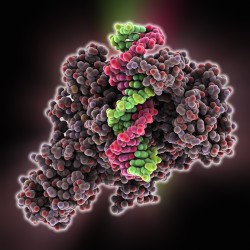
Research from the CSC’s Molecular Systems Group has revealed that a chemical modification of DNA found in human cells constitutes a novel source of mutations.
The team, led by Tobias Warnecke, found that cytosines – one of the four bases that make up DNA – were prone to mutate to guanines if they had undergone a process called hydroxymethylation, which occurs in some mammalian cells including neurons and stem cells.
The study, which was published in PLoS Genetics, shows that mutations from cytosine to guanine were 1.43 times more common at hydroxymethylated sites in humans and 1.22 times more common in mice compared to methylated cytosines – the more abundant cousins of hydroxymethylated cytosines.
Warnecke says that he was interested in the mutational effects of hydroxymethylated cytosine because methylated cytosine, which have a methyl group attached that alters how genes are expressed, are mutational hotspots in the human genome.
“This study highlights the fact that methylation is not the only DNA modification that comes at a cost. Rather, it seems that different DNA modifications each come with their own unique mutational burden. Knowing this allows us to better understand the pattern of mutations in the human population or in a cancer context,” he says.
Warnecke thinks that hydroxymethylated cytosines may alter DNA’s interaction with repair machinery, leaving hydroxymethylated cytosines at a greater risk to mutate to guanines.
The team uncovered the mutational burden of hydroxymethylation by comparing hundreds of human genomes to reconstruct mutations that happened in the recent past. “Here, we show the power of taking an evolutionary approach. Mutational processes that act from generation to generation leave footprints in the genome, so we can look at the genetic diversity that is present in human and mouse populations to try and identify the various mechanisms that underlie different mutation spectra,” he says.
Warnecke’s group worked in collaboration with the CSC’s Reprogramming and Chromatin Group, led by Petra Hajkova, and the CSC’s associate investigator Ben Lehner, Centre for Genomic Regulation Barcelona.
Publication: Supek F, Lehner B, Hajkova P, Warnecke T: Hydroxymethylated cytosines are associated with elevated C to g transversion rates PLoS Genetics (2014) 10(9):e1004585
Image credit: LAGUNA DESIGN/SCIENCE PHOTO LIBRARY
This work was supported by the Medical Research Council and Imperial College London. The Medical Research Council has been at the forefront of scientific discovery to improve human health. Founded in 1913 to tackle tuberculosis, the MRC now invests taxpayers’ money in some of the best medical research in the world across every area of health. Twenty-nine MRC-funded researchers have won Nobel prizes in a wide range of disciplines, and MRC scientists have been behind such diverse discoveries as vitamins, the structure of DNA and the link between smoking and cancer, as well as achievements such as pioneering the use of randomised controlled trials, the invention of MRI scanning, and the development of a group of antibodies used in the making of some of the most successful drugs ever developed. Today, MRC-funded scientists tackle some of the greatest health problems facing humanity in the 21st century, from the rising tide of chronic diseases associated with ageing to the threats posed by rapidly mutating micro-organisms. www.mrc.ac.uk
